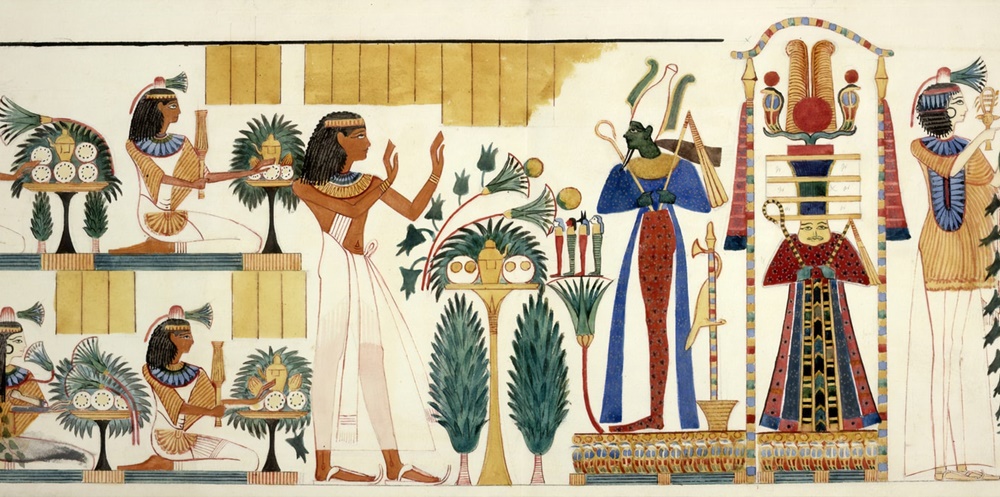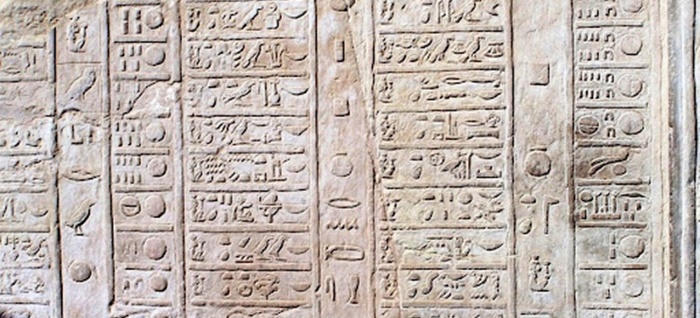Egyptian Zodiac, Astrology, Astronomy, and Calendar
In this post, we will talk about the Egyptian zodiac, astrology, astronomy, and calendar. In Egypt, when they referred to the sky as a heavenly body, they were not using a metaphor at all. In fact, the canopy of heaven was represented by the goddess Nut, depicted as a naked woman, lying on all fours above the ground; she managed to keep herself in this position thanks to Shu, the god of space and the atmosphere, who was positioned exactly between Heaven and Earth. Beneath Nut’s heavenly stomach and the star-spangled body were Geb – a divine, masculine figure personifying the Earth – lying on the side.
The most important thing you should know about the Egyptian zodiac is that there aren’t any signs. Egyptian zodiac consists only of constellations.

Re or Ra, the Sun, travelled the length of Nut’s body. For Nut, of course, had two bodies, diurnal and nocturnal. The first one was lying with its head looking west and its feet pointing east, or else, as it is sometimes more accurately shown, with its head looking north-west and its feet pointing south-east. The second one was the other way round. So Nut was divided into two. The goddesses’ two bodies were back to back.
Beneath Nut’s diurnal body, you could see figures representing the stars, boats marking the various stages of Ra’s journey during the course of a day and hieroglyphic texts. There were identical drawings beneath the second body, but they represented the nocturnal sky. So when you looked at the nocturnal sky the right way up to you were bound to see the diurnal sky upside down and vice versa.
This proves that although the Egyptians did not have the same understanding and view of the globe as us (and the Egyptian zodiac is not like ours), they did understand the principles of the diurnal sky and the night sky of the Sun’s continuous movement around their earth. They didn’t yet call it Earth, but looked upon it as a masculine divinity (Geb), whereas the Sky (Nut) was, in contrast to the way we see it today, feminine. They had also acquired the idea that, on the other side of the world, men lived and walked with their heads upside down.
Moreover, the reason Nut was always shown as a woman with a very thin, disproportionately long body was, of course, to represent the vastness of the canopy of heaven and the long journey made within her body by Ra, the Sun.
Learn ancient wisdom of Egyptian Numerology and discover your soul life contract. Learn more about the power in master numbers in Egyptian Numerology to navigate your life path.
Egyptian Astronomy and Calendar
It was, of course, the writer priests who, again in Egypt, observed the sky and the constellations and formed star ‘tables’. Nevertheless, it does seem that the Egyptians did not attribute divine or human characters to the planets and stars, as was the case in Mesopotamia and Babylon. On the other hand, the coincidences appearing between certain cyclical, repetitive, heavenly and earthly phenomena led them, as well, to establish rules and laws which are the origin of all the calendars and zodiacs in the world.

Thus, the first day in the year coincided with the first day of the flooding of the Nile. But it was also the day of Sirius’ heliacal rising. This star, located in the constellation of Canis Major, was called Sothis, the Dog star, by the Egyptians and they believed it represented the soul of Isis; in the same way, Orion was understood to represent the soul of Horus. Sirius’ heliacal rising took place on the day when, after being invisible for a time, it became visible again, at dawn, on the part of the horizon where the Sun rises.
The day when Sothis-Sirius was rising occurred around the 19th of July in our calendar. So the Egyptian new year started from the moment when these heavenly, hydrological phenomena coincided. Starting from that day, the year of the Egyptian calendar was divided into 360 days, or into 36 decans of 10 days, each of which had its own picture and symbols which put it under the subordination of a god. In fact, it is clear that we owe the breakdown of the solar year into 360 days to the Egyptians.
However, they realised that there were 5 days missing for the Sun to have made a complete yearly and zodiacal cycle. In order to ‘round off’ the year, they added these 5 days, which they dedicated to the main divinities of the Egyptian pantheon: Osiris, Horus, Seth, Isis and Nephthys. Nevertheless, the solar year of our calendar is a little more than 365 days long; and this was not done by the Egyptians.
So you had to wait 1460 years for the heliacal rising of Sirius to coincide exactly with the day of the flooding. Finally, the Egyptians had divided their calendar and zodiac into 3 seasons, each with 120 days:
- the first, flooding, from about 19th July to 18th November, depending on the years;
- the second, vegetation, from about 19th November to 18th March, still depending on the years;
- the third, harvesting, from about 19th March to 18th July, again, of course, depending on the years, for the reasons given below.
The Egyptian Zodiac
The Egyptian astrologers were of course priests and scribes. Egyptian zodiac was formed solely from the constellations and the twelve signs of the zodiac did not exist. However, they took the Sun and the Moon into account and also, like the Babylonians: Mercury, Venus, Mars, Jupiter and Saturn. It would appear that, almost up to the second half of the second millennium – which corresponds with the birth of the New Empire and the transfer of the capital to Thebes (now Luxor).
However, despite the fact that nowadays we view Egypt as a marvellous period of history spread over thousands of years, we find it difficult to imagine the everyday life of the Egyptians, their realism, and the way they adjusted themselves to the practical and social aspects of daily life, which were very important to them.
So it was probably in Thebes that, from the zodiac and Egyptian calendar, the ‘Thebaic’ or Theban calendar was formed, made up of 360 symbolic images, each with its own original meaning and corresponding just as well to the 360 days in the year as to the 360 degrees in the zodiac. This Thebaic calendar, which you will discover in future issues, will help you to understand and become initiated into Egyptian astrology.
